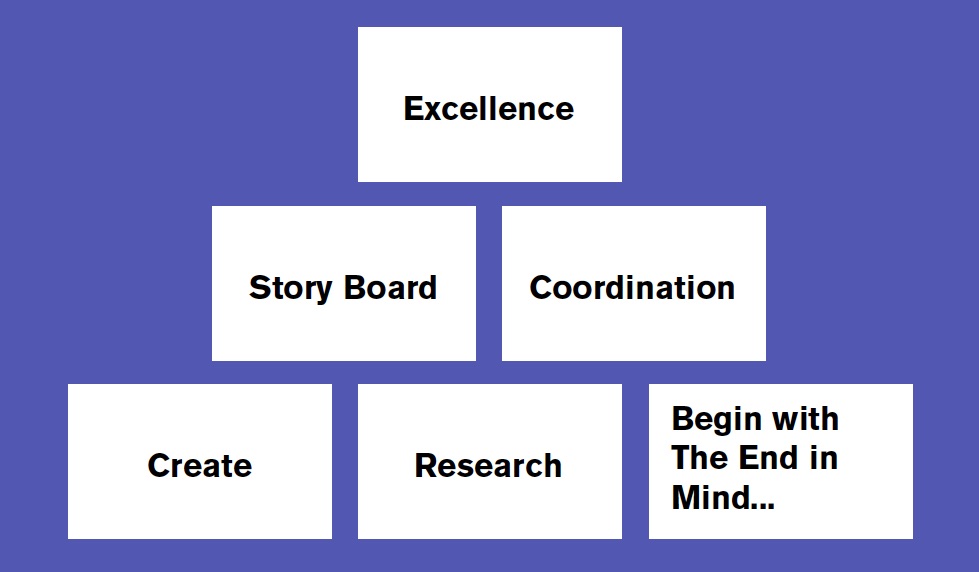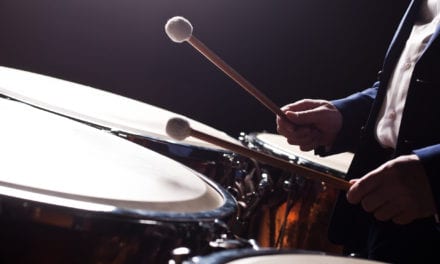by Kevin Ford, Director, Tarpon Springs High School and Co-Founder of INSPIRE…Music and Entertainment Productions
The design pyramid is my sequential method and approach for consideration during the process of building a production that is entertaining, thought provoking and effective. T is article will briefly outline some considerations for your thoughts and provide insight into the process which assists me when designing a product for my business Inspire Music and Entertainment Productions as well as Tarpon Springs High School.
1. Create:
In order to inspire your students, staff and community, every process must begin with enthusiasm and excitement for what you are doing. Remember, if you are performing your show for a football crowd as well as a “band audience”, it is important that the effectiveness and intellectual dialogue relate and be clear to all levels of your audiences. I encourage you to NOT overemphasize “how the judges will react,” but rather how your students, community and school will be affected by your program.
Questions for consideration when beginning your design process: a. Who is my audience and whom will we be performing for the most?
- List as many themes or musical compositions that might not only inspire your students but you and your staff as well.
- Which theme or musical composition encompasses the most variety and opportunity for musical, visual and general effect?
- Narrow down your theme or music for selection. If you have a theme and no music, do you have an experienced composer that could write a quality original composition for your story board that you have developed?
- Will this theme or show be educational and inspirational for your students, appealing to your community, and entertaining for your target audiences?
2. Research:
Once you have chosen your music or theme do as much research and exploration as possible. Explore thoughts and imagery that is outside of the marching band arena. Search for inspirations that are relevant to your theme or composition and that will allow you to bring something new to the activity and will generate an interest for the audience.
For example: In the 2005 Tarpon Springs High School “Pathways” production, my business partner Frank Sullivan and I listed as many paths, symbols and images that we could think of that would support or illustrate “Pathways.” We concluded this process with an enormous amount of information. Th is information ranged from different Pathways an individual could take with their lives, to several images and symbols that reflected direction, paths and our subject. It was through this research we began to build and specify exactly what message, motif and direction we wanted to conclude with. It became clear that we were inspired to use the “arrow” as a visual motif. It was at this point we decided that rather than having our guard spin equipment at the beginning of the show, we would use aluminum arrows, which would support our storyline and hopefully generate an effect that was different (see photo, right). It was also through this process that we narrowed down the five movements/pathways we were going to interpret musically and visually that provided us with the most emotional value and variety within our production.
If you are proceeding with an existing musical composition, I suggest you thoroughly research the composer. Find out exactly what inspired them to write that composition, see if that inspiration could provide you with some opportunities to build your visual identity and effect into your program.
Musical Considerations when developing your program:
- Do these musical selections provide an opportunity for different timbres, tempos, dynamics, tone colors and a variety of emotions to be explored?
- Can this music be effective at dynamic levels other than ff?
- Does this music allow my ensemble to play in a variety of different styles?
- Will this music assist in developing my students’ musical skills?
- Is the difficulty level of this music consistent with the ability level of my student musicians?
3. Begin with the End in Mind:
This is the point where you begin taking your research and ideas and begin to formulate them into an effective program. At this moment in the process, I encourage you to develop a clear vision of exactly how your program is going to begin and end. Consider what message, impressions, or emotions you want to leave your audience with. At Tarpon Springs, we call it designing from the “outside in.” We literally never design a program without knowing exactly how the show will begin and exactly how the show will conclude. This process allows you to build an infrastructure that offers a variety of emotions and effects that support a clear and consistent program from start to finish.
4. Story Board:
It is now time to develop your story board. Take all the research and information you have collected and develop this essential tool for your production. When developing your story board consider the following questions and see if any of these could be incorporated into the program:
- How can I best coordinate all three sections winds, percussion and auxiliary into your effect moments?
- Is there an opportunity for an isolation woodwind, brass, front ensemble or color guard “moment?”
- Is there an opportunity for the use of “Silence” to build tension and release?
- Where can you construct a pianissimo section for your winds and percussion and not just in a lyrical moment of your program?
- Is there a piece of equipment or prop that could be interactive and assists in supporting your story line?
Use of Text (narration)
It is important to note that if you use choose to use text or narration, you should never rely on that too explain your show design. Narration should be an enhancement that assists in conveying an emotion or message you’re trying to interpret in concert with the music. To effectively use narration, I would suggest it be written simultaneously with the music and not an after thought for explanation. The music must be appropriately interpretive of the narration and both must work together in rhythm and pattern to be effective. When using narration with Tarpon Springs, we actually write the music to the text. The text actually influences our choice in harmonies, rhythm patterns and colors of sound. We work towards creating an interactive partnership between the music, the visual presentation and the narration.
In the marching band arena the field is your stage, especially in a small band situation. You may want to consider alleviating some of the negative space on the field by changing the look or shape of the field. This will insure focus on your performers and create an intimate setting for our audience. At Tarpon Springs when we are planning a production, it is our intent and philosophy to turn the field into a literal supportive and interactive illustration of what we are trying to convey. It is our intention that with the combination of performers and the visual illustration we use as “props” that it appears to be a moving illustration from start to finish. It is important to note: Props sitting on the field with very little purpose or interaction by your performers will not in itself help create general effect. They must be integrated and incorporated into your production for them to serve a purpose and to have an impact on the overall effectiveness of your program.
The physical Story Board consists of the following components:
- Phrase and count structure for every phrase chronologically.
- Ideas for each phrase for all elements Winds, Percussion and Color Guard.
- Effect moments and what you are going to do specifically to generate the effect. Remember, the moments that lead you to the effect are equally important as the actual moment.
- Color: consider the following: Especially, in a “small band” situation, your choice of color can really enhance the impact of your musical moments. When you orchestrate the right colors and present them at the right time, it will give the illusion that there is actually more impact from the sonority of the ensemble than there actually is. Colors Saturation, sometimes called “color intensity” or brightness can also give a feeling of depth and space. The pacing and placement of color throughout your program should be lined up with the dynamic map of your musical program. Implement your color palette for each phrase and how it is going to enhance your effect moments. It may be important to your program that your color palette evolves in brightness throughout the show. Suggestion: if budget allows, you may consider avoiding the same color flag for the duration of an entire piece. You may consider choosing two flags that evolve in brightness as your music intensifies. The story board can assist you in carefully placing and pacing your colors so that you achieve a variety within your color palette throughout the duration of your program.
- Space: The variety and utilization of the space you choose to use can have a very positive impact on your effects. When working on your story board and planning out your production consider attaching a placement map as you go through the program. In coordination with your effects see to it that each effect you generate does not take place in the same area of the field.
5. Coordination:
When designing your effects it is imperative that you create collaboration within the entire band. I encourage you to place equal consideration when coordinating and planning your effects. Upon listening to your music selections and finding those “effect moments” within the piece, consider how all the elements can be featured in a harmonious fashion to best generate this effect. You will want to check yourself and make sure to create a balance throughout your program. Therefore, at the the conclusion of your entire production, you would not have relied on one element, one type of interpretation, or the same presentation for your effects.
6. Excellence:
Excellence is at the top of the pyramid because it is the most important. No matter how innovative or how well you design and coordinate all of your elements, your program will not be effective unless your students are playing, marching and spinning well. Your emphasis must be on quality first. A program can only be effective when the design and the execution are working harmoniously together. Despite the intentional interwoven contrasts of all of your elements in your program, your visual/musical picture should always convey a sense of balance and profound harmony. Throughout your presentation, a clear sense of connection and interdependence should always be evident. Your challenge as designer and educator will be to balance the execution of the performers with the innovative design qualities that will result in attaining equilibrium of an effective program. Regardless of the size of your band program, a systematic and organized approach when developing your program can result in an effective production that you, your students and your audience will all enjoy.



